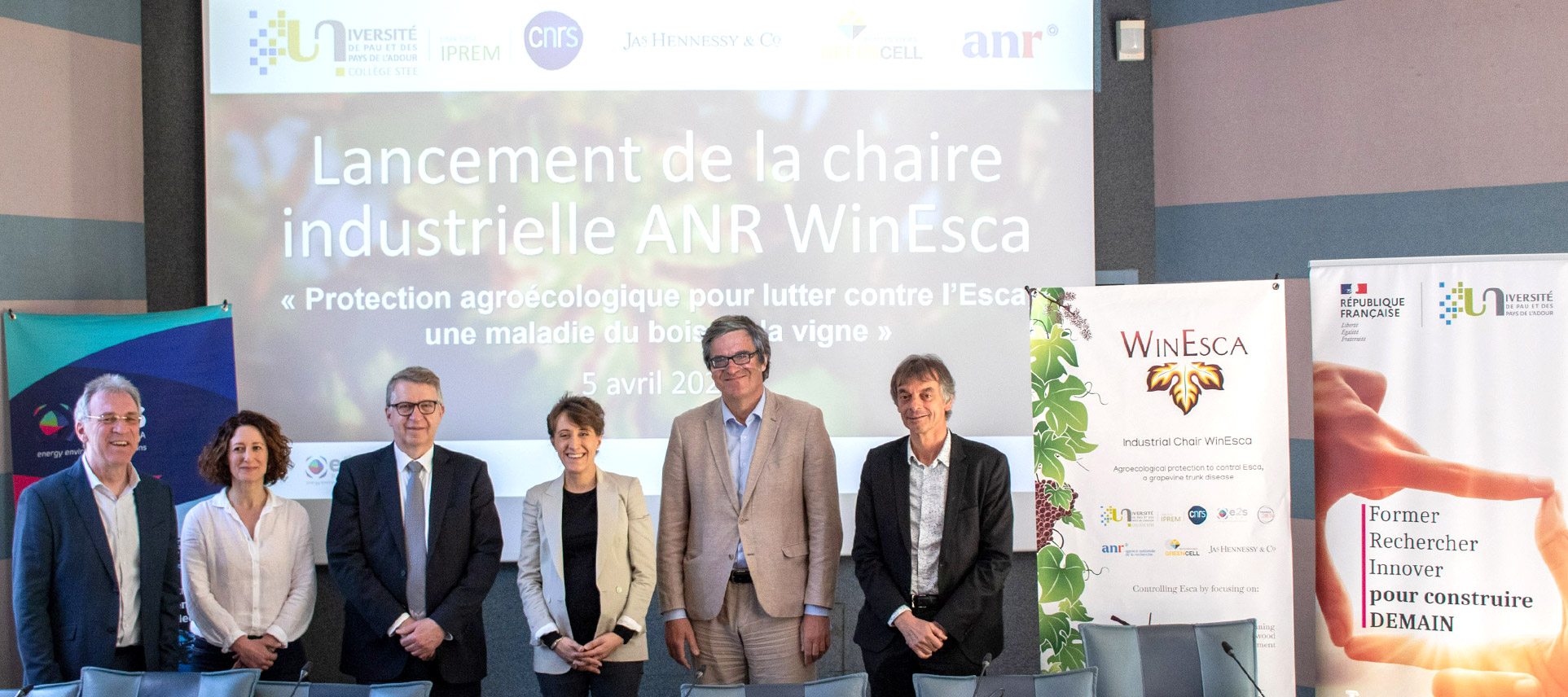A new research chair to fight esca, a grapevine trunk disease
5 Apr 2023
The official launch of the WinEsca industrial chair took place on Wednesday, April 5, 2023 in Pau. This chair, funded by the French National Research Agency (ANR), University of Pau and Pays de l'Adour, Jas Hennessy & Co, and GreenCell, aims to develop agroecological protection strategies.
The aim of WinEsca, the only industrial chair in agronomy in France, is to provide the wine industry with agroecological protection solutions to combat esca, a grapevine trunk disease known since antiquity but which is wreaking havoc due to the ban on the use of sodium arsenite in 2001.
Co-financed by the French National Research Agency (ANR) with €1.2 million, this industrial chair strengthens the collaboration initiated between the world leader in cognac Jas Hennessy & Co, IPREM (CNRS/University of Pau and the Pays de l'Adour), GreenCell and other scientific and academic partners.
It comes after a first chair, "GTDfree", launched in 2016 and whose scientific advances allow us to consider concrete control methods today.
A major challenge for the wine industry
With a positive trade balance of 14.2 billion euros in 2021, the wine industry contributes significantly to the French economy. The emblematic cognac sector was the leader in French exports of wines and spirits (3.6 billion euros in sales) in 2021.
Hennessy, the leading cognac producer in the world, exports 98% of its products. The company, which is present on all continents, is historically anchored in the Charente vineyards.
This 89,560 hectare vineyard, dedicated to the production of cognac eau de vie, has its own specificities such as the maintenance of vigorous plants and a reduced number of unproductive vines.
The harmful action of esca, a grapevine trunk disease (GTD), which affects about 18% of the cognac vineyards, is jeopardizing the objectives of the sector. On the rise again since the ban on the use of sodium arsenite in 2001, esca is reducing the longevity of the vines and affecting the quality of the wine in France, but also in the main wine-producing countries of the world.
Over the last few years, the estimated losses are considerable: nearly 12% of French vineyards are unproductive because of wood diseases, mainly esca, resulting in a production loss of about one billion euros. It is thus one of the key elements of French agriculture and cultural heritage that is threatened.
This observation contradicts the overall development prospects of the industry and those of Hennessy in particular.
Designing agroecological protection against esca
The WinEsca project aims to control esca by focusing on the following key points:
- Preventive control. Limiting the development of necroses in the wood, by applying virtuous pruning methods. The physiology, including the sap flow of the plant, and the evolution of the microflora related to the early appearance of necroses in the wood will be monitored.
- Preventive & curative control. Biocontrol agents will be applied at planting to achieve a preventive protection. Vines will be treated by targeting the necrosis called amadou, which is typical of esca. For this purpose, bacteria inhibiting the main pathogenic fungus of amadou, Fomitiporia mediterranea, will be introduced into this necrosis.
- Socio-economic evaluation. To evaluate the economic aspect of the proposed solutions and the benefits that the wine growers will be able to obtain. The societal acceptance of biocontrol, i.e. by wine growers and consumers, will also be studied.
The results of this agroecological protection project, in line with current environmental considerations, will benefit the cognac viticulture sector, but also more widely to French and international vineyards.
ANR Industrial Chairs
Since 2012, the French National Research Agency has funded 55 industrial chair projects that have been rigorously selected for their scientific quality, strong and lasting partnership with private players, the scientific reputation of the project leader and his or her ability to structure a high-level research ecosystem in a strategic field for the public and private players involved in the project.
In this context, the WinEsca industrial chair can be considered a perfect example because it combines:
- a strong and long-lasting partnership between the holder and the main industrial partner, an amplification of the ambition compared to a previous partnership, and the inclusion of a new industrial partner;
- an academic ecosystem that benefits from the environment offered by the I-SITE label;
- training through research of several young graduates and researchers on a theme with high economic and ecological potential.
As a reminder…
The previous industrial chair, "GTDfree", launched in 2016 with INRAE and Jas Hennessy & Co, provided scientific lessons that were precursors to the current work.
- Confirmation of the positive influence of the pruning system and the "virtuous" gesture: evidence of the role of sap flow in esca
- Identification of the main species of fungus (Fomitiporia mediterranea) involved in the appearance of wood diseases
- Identification of fungus/bacteria associations that degrade wood
- Discovery of bacteria capable of inhibiting the development of esca in vitro: prospects for the development of biocontrol solutions
